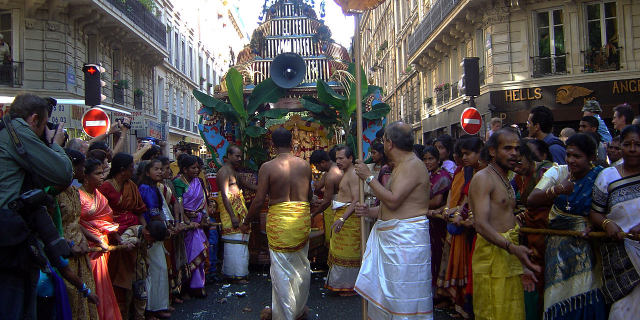श्री रंगनाथस्वामी मंदिर, श्रीरंगम
( Ranganathaswamy Temple, Srirangam )
The Ranganathaswamy Temple is a Hindu temple dedicated to Ranganatha (a form of Vishnu) and is located in Srirangam, Tiruchirapalli, Tamil Nadu, India. Constructed in the Dravidian architectural style, the temple is glorified by the Tamil poet-saints called the Alvars in their canon, the Naalayira Divya Prabhandam, and has the unique distinction of being the foremost among the 108 Divya Desams dedicated to the god Vishnu. The Srirangam temple is the largest temple compound in India and is one of the largest religious complexes in the world. Some of these structures have been renovated, expanded and rebuilt over the centuries as a living temple. The latest addition is the outer tower that is approximately 73 metres (240 ft) tall, it was completed in 1987. Srirangam temple is often listed as the largest functioning Hindu temple in the world, the still larger Angkor Wat being the largest existing temple. The temple is an active Hindu house of worsh...Read more
The Ranganathaswamy Temple is a Hindu temple dedicated to Ranganatha (a form of Vishnu) and is located in Srirangam, Tiruchirapalli, Tamil Nadu, India. Constructed in the Dravidian architectural style, the temple is glorified by the Tamil poet-saints called the Alvars in their canon, the Naalayira Divya Prabhandam, and has the unique distinction of being the foremost among the 108 Divya Desams dedicated to the god Vishnu. The Srirangam temple is the largest temple compound in India and is one of the largest religious complexes in the world. Some of these structures have been renovated, expanded and rebuilt over the centuries as a living temple. The latest addition is the outer tower that is approximately 73 metres (240 ft) tall, it was completed in 1987. Srirangam temple is often listed as the largest functioning Hindu temple in the world, the still larger Angkor Wat being the largest existing temple. The temple is an active Hindu house of worship and follows the Tenkalai tradition of Sri Vaishnavism. The annual 21-day festival conducted during the Tamil month of Margali (December–January) attracts 1 million visitors. The temple complex has been nominated as a UNESCO World Heritage Site, and is in UNESCO's tentative list. In 2017 the temple won the UNESCO Asia Pacific Award of Merit 2017 for cultural heritage conservation, making it the first temple in Tamil Nadu to receive the award from the UNESCO.
It is among the most illustrious Vaishnava temples in South India rich in legend and history. Beyond the ancient textual history, archaeological evidence such as inscriptions refer to this temple, and these stone inscriptions are from late 100 BCE to 100 CE. Hence, "making it one of the oldest surviving active temple complexes in South India". The deity finds a mention in the Sanskrit epic Ramayana which is dated around 800 to 400 BCE which also pushes the existence of deity to the same era. The temple has played an important role in Vaishnava history starting with the 11th-century career of Ramanuja and his predecessors Nathamuni and Yamunacharya in Srirangam. Its location, on an island between the Kollidam and Kaveri rivers, has rendered it vulnerable to flooding as well as the rampaging of invading armies which repeatedly commandeered the site for military encampment. The temple was looted and destroyed by the Delhi Sultanate armies in a broad plunder raid on various cities of the Pandyan kingdom in early 14th century. The temple was rebuilt in late 14th century, the site fortified and expanded with many more gopurams in the 16th and 17th centuries. It was one of the hubs of early Bhakti movement with a devotional singing and dance tradition, but this tradition stopped during the 14th century and was revived in a limited way much later.
The temple occupies an area of 63 hectares (155 acres) with 81 shrines, 21 towers, 39 pavilions, and many water tanks integrated into the complex. The temple town is a significant archaeological and epigraphical site, providing a historic window into the early and mid medieval South Indian society and culture. Numerous inscriptions suggest that this Hindu temple served not only as a spiritual center, but also a major economic and charitable institution that operated education and hospital facilities, ran a free kitchen, and financed regional infrastructure projects from the gifts and donations it received.
The main deity of the temple is mentioned in various Sanskrit literature and epics such as the Ramayana,[1][2][3] Mahabharata,[4] Padma Purana, Brahmanda Purana[5] and Garuda Puranam. There are mentions even in the Tamil literature of the Sangam era (500 BCE to the 300 CE[6]), there are mentions in many books like Akanaṉūṟu, Purananuru, Paripāṭal and Silapadikaram. Example:- Silapadikaram (book 11, lines 35–40):[7]
āyiram viritteḻu talaiyuṭai aruntiṟaṟ pāyaṟ paḷḷip palartoḻu tētta viritiraik kāviri viyaṉperu turuttit tiruvamar mārpaṉ kiṭanta vaṇṇamum
On a magnificent cot having a thousand heads spread out, worshipped and praised by many, in an islet surrounded by Kaveri with billowing waves, is the lying posture of the one who has Lakshmi sitting in his chest
Silapadikaram (book 11, lines 35–40)[8]
The temple was first built by the Chola ruler, Dharmavarma. The Kaveri river flood destroyed the temple vimanam, and later, the early Cholas King Killivalavan rebuilt the temple complex that is present today. Beyond the ancient textual history, archaeological evidence such as inscriptions indicate that stone inscriptions are from late 100 BCE to 100 CE.[9] Hence, making it one of the oldest surviving active temple complexes in South India.[9] There are many mandapas which were built near the main sanctum sanctorum which dates around 100 CE to 300 CE built by Uraiyur Cholas. There were later additions of structures and inscriptions in the temple which belong to the Chola, Pandya, Hoysala, Marathas and Vijayanagara dynasties who ruled over the region. These inscriptions range in date between the 7th and 17th centuries.[10]
During the period of invasion and plunder by the Alauddin Khilji's Muslim general Malik Kafur and his Delhi Sultanate forces in 1311, the Arabic texts of the period state that he raided a "golden temple" on river "Kanobari" (Kaveri), destroyed the temple and took the plunder with the golden icon of the deity to Delhi. According to Steven P. Hopkins, this is believed to be the Ranganathaswamy Temple.[11]
The Tamil texts that followed offer various inconsistent legends on how the temple regained the Vishnu icon. According to one found in Koil Oluku, a young girl had vowed to fast till she had seen the icon.[11] She followed the Muslim army as it returned with the loot back to Delhi. There she sneaked into the palace and saw that the Sultan's daughter had fallen in love with the image. The young girl returned to Srirangam and told the priests about what she had seen in Delhi. The priests went with musicians to Delhi, found the icon in capriciously playful possession of the Sultan's daughter, day and night.[11] They sang and danced before the Sultan to return the icon, and he gave it back which upset his daughter. To console the daughter, the Sultan sent in his army again to bring it back, but this time they were not successful.[11] According to other versions, the Muslim daughter followed the icon from Delhi to Srirangam on a horse and still not seeing the idol, gave up her life before the door of the sanctum, symbolizing that love brought back the icon after the war had taken it away.[12][13]
 An 1870 photo of the gopurams in the temple town.
An 1870 photo of the gopurams in the temple town.Beyond these legends, there was a more severe second invasion of South India including Srirangam between 1323 CE and 1327 CE by the armies of the Sultanate under Muhammad bin Tughluq.[14] The sanctum's Vishnu image with its jewelry was pre-emptively removed by the Hindus before the Delhi Sultanate troops reached Srirangam by a group led by the Vaishnavite Acharaya Pillai Lokacharyar to Tirunelveli in Tamil Nadu. The goddess Ranganayaki (Lakshmi) was also taken away to another location by a separate group. The temple was defended and according to the Tamil tradition some 13,000 Sri Vaishnavas devotees of Srirangam, died in the fierce battle.[15]
After nearly six decades when Madurai Sultanate ruled after the Pandyan rulers were ousted after the repeated Delhi Sultanate's invasions, the Vijayanagara Empire ousted the Madurai Sultanate in 1378.[16][17][18] Thereafter, the image of Namberumal was brought back to Srirangam.[15] Before then, for decades the deity and the priestly wardens wandered and secretly carried the temple's icon through villages of Tamil Nadu, Kerala and Karnataka. They finally went to the hills of Tirumala Tirupati, where they remained until the temple was rebuilt in 1371.[19] The icon was consecrated again according to the legends. This time, in memory of the first Sultan's daughter which tradition calls Thulukha Nachiyar, a niche in the temple was built for her. The niche shows her as a girl sitting on a horse that carried her to Delhi. Her legend is still remembered. During contemporary processions when the icon is taken out of sanctum and then returned to it after its journey, Thulukha Nachiyar is dressed in Muslim garments and food offerings are made to her in the form of butter and chappathis (wheat bread).[20]
Thereafter, under the Vijayanagara Empire, the temple site saw over 200 years of stability, repairs, first round of fortifications, and addition of mandapas.[21] The Vishnu and Lakshmi images were reinstalled and the site became a Hindu temple again in 1371 CE under Kumara Kampana, a Vijayanagara commander and the son of Bukka I.[22] In the last decade of the 14th century, a pillared antechamber was gifted by the Vijayanagara rulers. In the 15th century, they coated the apsidal roofs with solid gold sheets, followed by financing the addition of a series of new shrines, mandapas and gopuras to the temple, according to George Michell.[22]
After the destruction of the Vijayanagara in late 16th century, geo-political instability returned. The site became the focus of bitter wars between the Hindu Nayakas and the Muslim Mughals in the 17th century.[23] The Nayakas fortified the temple town and the seven prakaras. It was taken over by Muslim Nawabs of Arcot as a lucrative source of revenues, and thereafter attracted a contest between the French and British military powers.[24] Srirangam temple site and the neighboring city of Tiruchirappalli (Trichy) became an intense center of Christian and Muslim missionary activity during the 18th and 19th centuries.[23] With the establishment of the Madras Presidency within the British Empire, geo-political stability returned and the Ranganathaswamy Temple site attracted interest in archeological and historical studies.[23]
The epigraphical evidence suggests that these Hindu dynasties — Cholas, Pandyas, Hoysalas, Gajapatis, Nayaks, Vijayanagara – assisted with rebuilding, renovation and supported the traditional customs. Some mention substantial gifts to the temple. A Chola king, for example, presented the temple with a golden serpent couch. Some historians identify this king with Rajamahendra Chola. The temple has witnessed and played a key role in the early Sri Vaishnavism history, particularly the centuries that followed the major Hindu philosopher Ramanuja (1017–1137 CE), and his predecessors Nathamuni and Yamunacharya.[25][26] It witnessed the debate between the Dvaita (dualistic) and Advaita (non-dualistic) sub-traditions within Vaishnavism. Centuries later, it was a key site in the debate and disagreements between the northern Tamil and southern Tamil traditions, also called as the Vadakalai and Tenkalai.[27] The early rulers such as the Pallavas, Cholas and Pandyas supported it as a hub of the Bhakti movement with a devotional singing and dance tradition, but this tradition stopped during the 14th century and was revived in a limited way much later.[28]



































Add new comment